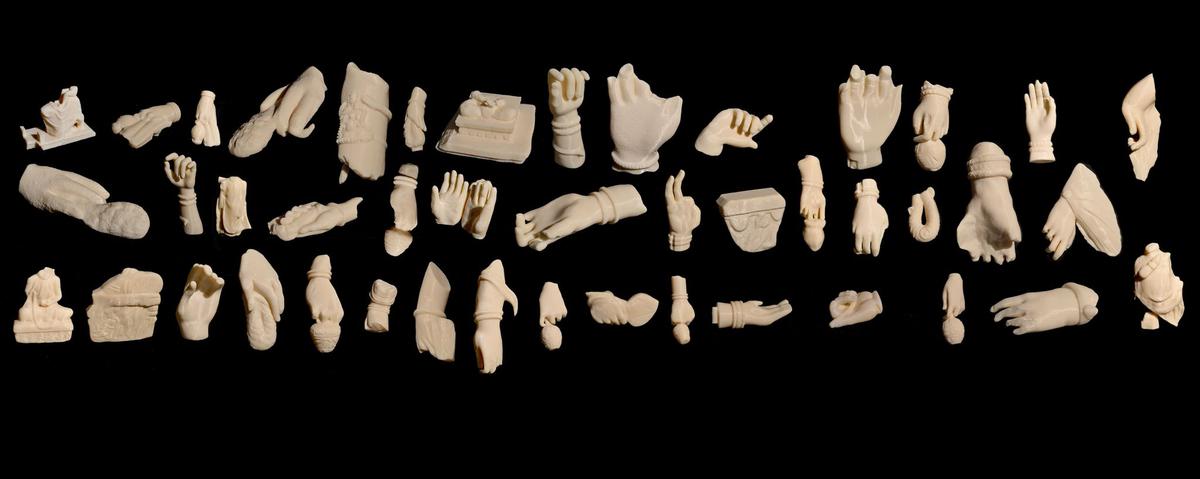Shaurya Kumar’s solo exhibition in Delhi There is no god in the temple
| Photo Credit: SPECIAL ARRANGEMENT
What happens when the walls of the sanctum crumble or the tombs are emptied, columns of temples and idols are carted off to mantles of private collectors or cultural artefacts vanish without a trace and temples are left in ruins?
“The devotee’s faith in divinity is shaken and the memory of the object gets fragmented,” says artist Shaurya Kumar whose ongoing exhibition at the Threshold Gallery puts out a stark and meaningful representation of long-vanished slices of history.
The exhibition is an eclectic collection of miniature paintings, 3-D sculptures and gold leaf imprints on paper drawings that attempt to fathom what objects tell us about history, society, nature or culture when they are destroyed or distorted and how it shakes up people when their deities are looted.

Shaurya Kumar’s solo exhibition in Delhi There is no god in the temple
| Photo Credit:
SPECIAL ARRANGEMENT
The title is drawn from Tagore’s poem echoing the sentiments of the people who found their shrines and altars desecrated. It forms the central piece with a porcelain installation on a gold wall that carries the Bengali title Oi mondire kono debota nei, (There Is No God in the Temple) as a 3D black sculpture of Nandi looks on.
The first work he made for this collection, It’s Mine, No It’s Mine, Now It’s Yours, No It’s Ours, Now It’s Missing! has a dozen 3-D printed sculptures of varying sizes arranged on a handwoven tapestry with wool and dye made to look like a chausar board. Shaurya explains that the person who holds the dice is the one who decides the fate of the sculpture. If you throw the dice, it keeps changing ownership from ‘mine’ to ‘ours’, poignantly underlying the sentiments behind stolen artefacts.
It was the 2003 CAG report highlighting the disappearance of 92 monuments from India that intrigued Shaurya Kumar, then a 24-year-old graduate of Delhi College of Art. A recent UNESCO study estimating that 50,000 idols and artifacts were smuggled out of India between 1947 and 1989 and 2,208 sculptures and idols looted from temples where they were still being worshipped, between 2008 and 2012, further piqued his curiosity.
“The plunder in India happened during peace time, when the country was not in religious or political turmoil, unlike events in the Middle and near East where ancient religious sites and artefacts were destroyed by the extremist forces,” says Shaurya, now a professor at the School of the Art Institute of Chicago.

Shaurya Kumar’s solo exhibition in Delhi There is no god in the temple
| Photo Credit:
SPECIAL ARRANGEMENT
A 2015 article in The New York Times about an American art dealer of Indian origin, who was recently convicted for the illegal export of 19 antique idols to his gallery in New York, made Shaurya re-examine the definition of divinity in objects and the iconoclasm of destruction. “These thefts were not from any political or economic standpoint but stolen from a temple which has a spiritual connotation,” he says.
Shaurya describes himself as an artist of recollection who immerses himself in history and imagery of memory and time. In his workks, he addresses the loss of aura. He does not question the physical form of a fallen and forgotten object but probes the subject-object relationship in a particular time and context and subtly questions the purpose of destruction.
There are several distinctive pieces that set the tone of the exhibition. The sculpture, ‘A Case of the Broken Hands’ includes reproduction of black-and-white photographs of 40 unidentified sculptures reflecting the tactical and visual engagement between the devotee and the divine and provides a critical understanding of religious and spiritual realization
At Threshold Art Gallery, C-221, Sarvodaya Enclave; Till December 20; 11 am to 7 pm


